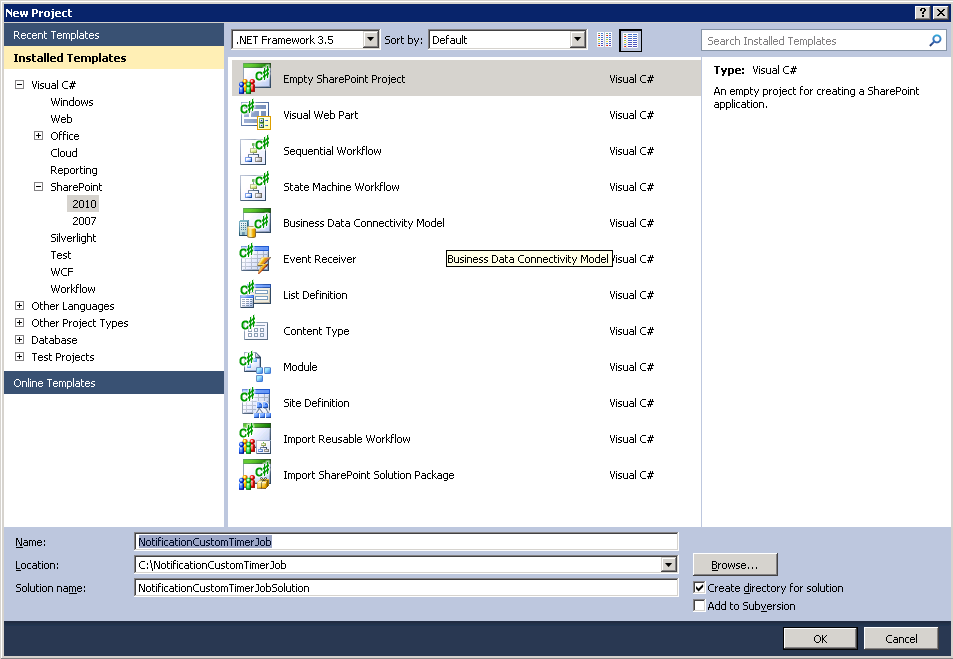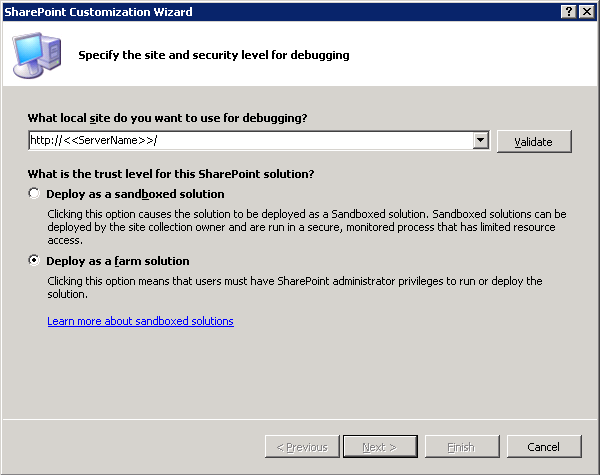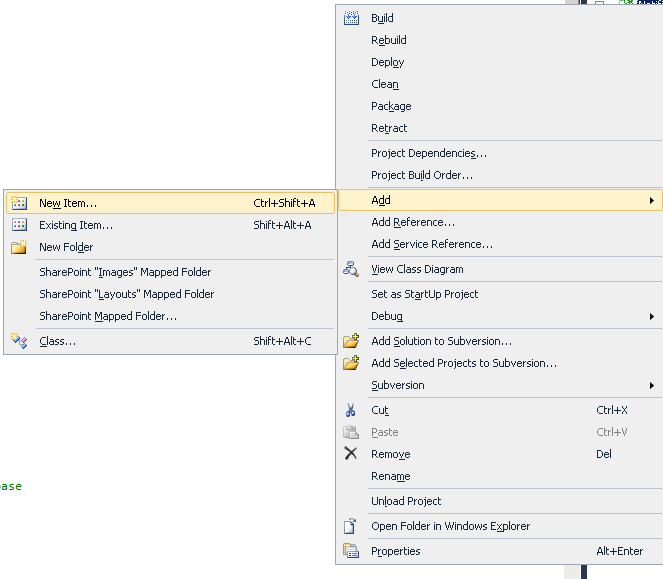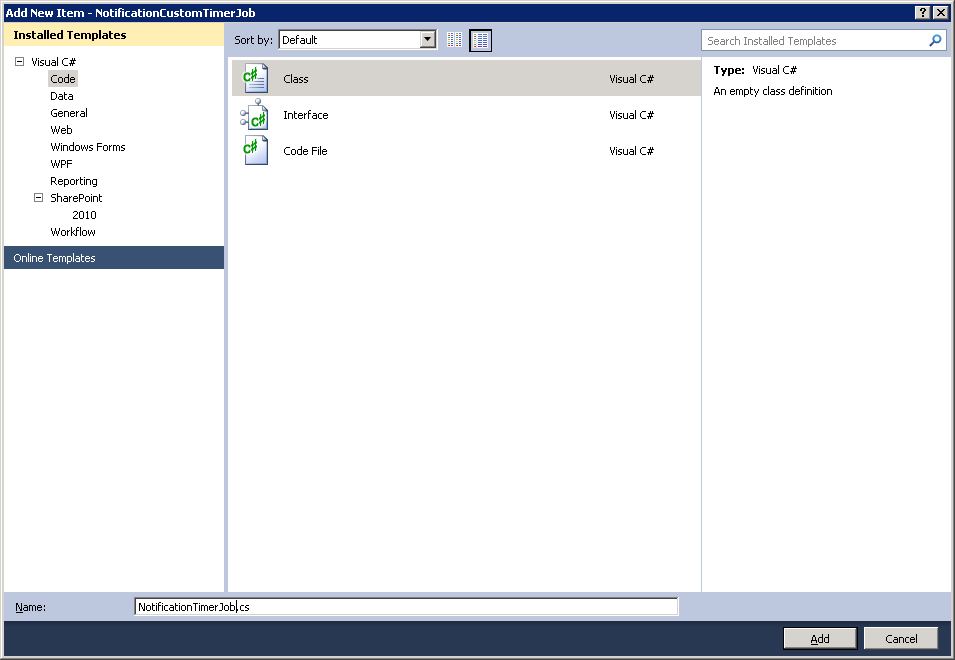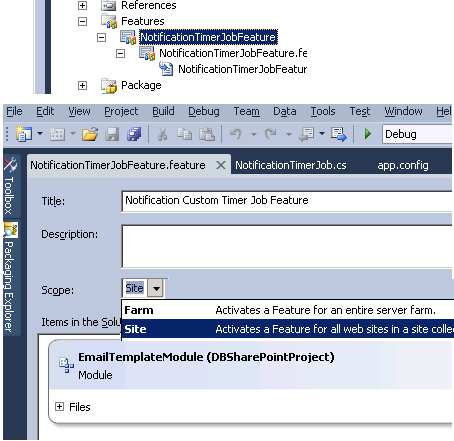SharePoint 2010 Custom Timer Job - Send an Email
1. Open Visual Studio 2010 and goto FILE -> New Project -> Empty SharePoint Project.
2. Select SharePoint 2010 under Installed Templates under left Navigation.
3. Select Deploy as Farm Solution Option and replace https://<<ServerName>>/ with proper URL of the SharePoint site.
4. Right Click on the Project and Create a New Item
5. Select Code from Installed Templates of left Navigation and name the file as "NotificationTimerJob.cs"
6. Paste the following code
using System;
using System.Collections.Generic;
using System.Linq;
using System.Text;
using Microsoft.SharePoint.Administration;
using Microsoft.SharePoint;
using System.Net.Mail;
namespace NotificationCustomTimerJob
{
public class NotificationTimerJob : Microsoft.SharePoint.Administration.SPJobDefinition
{
/// <summary>
/// Default Consructor
/// </summary>
public NotificationTimerJob()
: base()
{
}
/// <summary>
/// Parameterized Constructor
/// </summary>
/// <param name="jobName">Name of Job to display in central admin</param>
/// <param name="service">SharePoint Service </param>
/// <param name="server">Name of the server</param>
/// <param name="targetType">job type is for content db or job</param>
public NotificationTimerJob(string jobName, SPService service, SPServer server, SPJobLockType targetType)
: base(jobName, service, server, targetType)
{
}
/// <summary>
/// Parameterized Constructor
/// </summary>
/// <param name="jobName"></param>
/// <param name="webApplication"></param>
public NotificationTimerJob(string jobName, SPWebApplication webApplication)
: base(jobName, webApplication, null, SPJobLockType.ContentDatabase)
{
this.Title = "Email Notification Job";
}
/// <summary>
/// Execute method called when the timer job starts executing. It runs on "DB News Announcements" list which checks for all
/// approved annoucements and sends out an email to all users for all approved news.
/// </summary>
/// <param name="contentDbId"></param>
public override void Execute(Guid contentDbId)
{
string from = string.Empty;
string smtpAddress = string.Empty;
string to = "someone@somecompany.com";
string subject = "Email Notification";
string body = "<h1> Email Sending from Email Notification Job </h1>";
SPSecurity.RunWithElevatedPrivileges(delegate()
{
// get a reference to the current site collection's content database
SPWebApplication webApplication = this.Parent as SPWebApplication;
SPContentDatabase contentDb = webApplication.ContentDatabases[contentDbId];
// get a reference to the "Tasks" list in the RootWeb of the first site collection in the content database
SPWeb rootWeb = contentDb.Sites[0].RootWeb;
// Get the DB News Announcements List
SPList listjob = rootWeb.Lists.TryGetList("Tasks");
// Get sender address from web application settings
from = rootWeb.Site.WebApplication.OutboundMailSenderAddress;
// Get SMTP address from web application settings
smtpAddress = rootWeb.Site.WebApplication.OutboundMailServiceInstance.Server.Address;
// Send an email if the news is approved
bool emailSent = SendMail(smtpAddress, subject, body, true, from, to, null, null);
if (listjob != null && emailSent)
{
SPListItem newListItem = listjob.Items.Add();
newListItem["Title"] = string.Concat("Email Notification Sent at : ", DateTime.Now.ToString());
newListItem.Update();
}
});
}
/// <summary>
/// Send an email to indented users
/// </summary>
/// <param name="smtpAddress">SMTP address to sending email</param>
/// <param name="subject">subject of email</param>
/// <param name="body">body of email</param>
/// <param name="isBodyHtml">whether body is html or text</param>
/// <param name="from">from address</param>
/// <param name="to">to users(multiple email address can be seperated by comma(,) )</param>
/// <param name="cc">cc users</param>
/// <param name="bcc">bcc users</param>
/// <returns>Status whether email successfully sent or not</returns>
public bool SendMail(string smtpAddress, string subject, string body, bool isBodyHtml, string from, string to, string cc, string bcc)
{
bool mailSent = false;
SmtpClient smtpClient = null;
try
{
// Assign SMTP address
smtpClient = new SmtpClient();
smtpClient.Host = smtpAddress;
//Create an email message
MailMessage mailMessage = new MailMessage(from, to, subject, body);
if (!String.IsNullOrEmpty(cc))
{
MailAddress CCAddress = new MailAddress(cc);
mailMessage.CC.Add(CCAddress);
}
if (!String.IsNullOrEmpty(bcc))
{
MailAddress BCCAddress = new MailAddress(bcc);
mailMessage.Bcc.Add(BCCAddress);
}
mailMessage.IsBodyHtml = isBodyHtml;
// Send the email
smtpClient.Send(mailMessage);
mailSent = true;
}
catch (Exception)
{
mailSent = false;
}
return mailSent;
}
}
}
7. Now add a new feature
Rename the feature to NotificationTimerJobFeature and add add an event receiver for registering the timer job and scheduling it for every 5 minutes. Change the scope to Site
9. Paste the below code snippet in event receiver for Feature activation and deactivation.
using System;
using System.Runtime.InteropServices;
using System.Security.Permissions;
using Microsoft.SharePoint;
using Microsoft.SharePoint.Security;
using System.Linq;
namespace NotificationCustomTimerJob.Features.NotificationTimerJobFeature
{
/// <summary>
/// This class handles events raised during feature activation, deactivation, installation, uninstallation, and upgrade.
/// </summary>
/// <remarks>
/// The GUID attached to this class may be used during packaging and should not be modified.
/// </remarks>
[Guid("67388410-1290-41d2-8645-5a1203b27bc4")]
public class NotificationTimerJobFeatureEventReceiver : SPFeatureReceiver
{
// Name of the Timer Job, but not the Title which is displayed in central admin
private const string List_JOB_NAME = "NotificationTimerJob";
// Uncomment the method below to handle the event raised after a feature has been activated.
public override void FeatureActivated(SPFeatureReceiverProperties properties)
{
SPSecurity.RunWithElevatedPrivileges(delegate()
{
SPSite site = properties.Feature.Parent as SPSite;
// make sure the job isn't already registered
site.WebApplication.JobDefinitions.Where(t => t.Name.Equals(List_JOB_NAME)).ToList().ForEach(j => j.Delete());
// install the job
NotificationTimerJob listLoggerJob = new NotificationTimerJob(List_JOB_NAME, site.WebApplication);
SPMinuteSchedule schedule = new SPMinuteSchedule();
schedule.BeginSecond = 0;
schedule.EndSecond = 59;
schedule.Interval = 5;
listLoggerJob.Schedule = schedule;
listLoggerJob.Update();
});
}
// Uncomment the method below to handle the event raised before a feature is deactivated.
public override void FeatureDeactivating(SPFeatureReceiverProperties properties)
{
SPSecurity.RunWithElevatedPrivileges(delegate()
{
SPSite site = properties.Feature.Parent as SPSite;
// delete the job
site.WebApplication.JobDefinitions.Where(t => t.Name.Equals(List_JOB_NAME)).ToList().ForEach(j => j.Delete());
});
}
// Uncomment the method below to handle the event raised after a feature has been installed.
//public override void FeatureInstalled(SPFeatureReceiverProperties properties)
//{
//}
// Uncomment the method below to handle the event raised before a feature is uninstalled.
//public override void FeatureUninstalling(SPFeatureReceiverProperties properties)
//{
//}
// Uncomment the method below to handle the event raised when a feature is upgrading.
//public override void FeatureUpgrading(SPFeatureReceiverProperties properties, string upgradeActionName, System.Collections.Generic.IDictionary<string, string> parameters)
//{
//}
}
}
10. Deploy the feature by right click on the project and deploy.
11. Now navigate to Central Administration -> Monitoring -> Review Job Definitions under Timer Jobs section.
12. Administrator can change the settings of the timer job schedule. Now this job sends an email and adds a Task in the task list.
